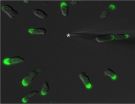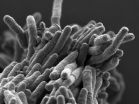(Press-News.org) Scientists at the University of California, Davis, have identified a key mechanism in neuropathic pain. The discovery could eventually benefit millions of patients with chronic pain from trauma, diabetes, shingles, multiple sclerosis or other conditions that cause nerve damage.
A biological process called endoplasmic reticulum stress, or ER stress, is the significant driver of neuropathic pain, said lead researchers Bora Inceoglu of the UC Davis Department of Entomology and Nematology and UC Davis Comprehensive Cancer Center, and Ahmed Bettaieb, Department of Nutrition. The work is published July 6 in the journal Proceedings of the National Academy of Sciences.
"This is a fundamental discovery that opens new ways to control chronic pain," said co-author Bruce Hammock, distinguished professor at the UC Davis Department of Entomology and Nematology and the UC Davis Comprehensive Cancer Center.
"We can now specifically search for agents to control ER stress and its downstream pathways," Hammock said. "This search is already underway in a number of laboratories working on cancer and other diseases."
Working with Professor Fawaz Haj of the UC Davis nutrition department, Bettaieb found that key molecular signatures associated with diabetes and diabetic pain were linked to ER stress. Neuropathic pain is a common consequence of both Type 1 and Type 2 diabetes, affecting up to 70 percent of patients.
Inceoglu, working in Hammock's laboratory, showed that neuropathic pain could be initiated by compounds that cause ER stress and reversed by agents that block it.
The researchers had previously shown that a class of natural bioactive lipids has powerful analgesic effects in the body. These analgesic lipids are broken down in the body by an enzyme, soluble epoxide hydrolase. The team was able to show that blocking soluble epoxide hydrolase blocks ER stress and associated neuropathic pain.
The work sheds new light onto at least one biological process that mediates neuropathic pain, Inceoglu said. With this knowledge, researchers can now test ER-stress blocking drugs in the clinic, and carry out fundamental research on how different types of pain grouped under the name "neuropathic" differ from each other and respond to new drugs.
The study provides convincing evidence for a novel concept as to what causes neuropathic pain said John Imig, professor of pharmacology and toxicology at the Medical College of Wisconsin, Milwaukee, who was not involved in the study. The work provides new opportunities for drugs or drug combinations to treat chronic pain, he said.
INFORMATION:
Additional authors on the paper are Kin Sing Stephen Lee and Carlos Trindade da Silva, both at the UC Davis Department of Entomology and Nematology and the UC Davis Comprehensive Cancer Center.
The research was supported by grants from the National Institute of Environmental Health Sciences and NIEHS Superfund Basic Research Program grant, National Institutes of Health, and the National Institute of Arthritis and Musculoskeletal and Skin Disease.
Media contacts:
-- Bruce Hammock, Entomology and Nematology, (530) 752-7519, bdhammock@ucdavis.edu
-- Fawaz Haj, Nutrition, (530) 752-3214, fghaj@ucdavis.edu
-- Kathy Keatley Garvey, Entomology and Nematology, (530) 754-6894, kegarvey@ucdavis.edu
-- Pat Bailey, UC Davis News Service, (530) 752-9843, pjbailey@ucdavis.edu
LOS ANGELES (July 6, 2015) - Cedars-Sinai researchers have successfully tested two new methods for preserving cognition in laboratory mice that exhibit features of Alzheimer's disease by using white blood cells from bone marrow and a drug for multiple sclerosis to control immune response in the brain.
Under the two approaches, immune cells from outside the brain were found to travel in greater numbers through the blood into the brain. The study showed measurable benefits in mice, an encouraging step toward further testing of these potentially powerful strategies in human ...
New research suggests guidelines on children's exposure to radio frequency waves from technology are confusing for parents.
The review into the polices of 34 countries, carried out by Dr Mary Redmayne, from the Department of Epidemiology and Preventive Medicine at Monash University, found varying degrees of advice about children's exposure to radio frequency electromagnetic fields (RF-EMF).
RF-EMFs are emitted from technology including WiFi, tablets and mobile phones. Associated with an increased risk of some brain tumours in heavy and long-term phone users, RF-EMFs ...
ARLINGTON HEIGHTS, Ill. (July 7, 2015) - Parents of kids with severe allergies know how scary a severe allergic reaction (anaphylaxis) is. New research offers clues as to why some kids can have a second, related reaction hours later - and what to do about it.
A study in the Annals of Allergy, Asthma and Immunology, the scientific publication of the American College of Allergy, Asthma and Immunology (ACAAI), examined records of 484 children seen in an emergency department (ED) for anaphylaxis. The researchers tracked whether there was a second, follow-up reaction. Delayed ...
When Greek mythology and cell biology meet, you get the protein Callipygian, recently discovered and named by researchers at The Johns Hopkins University for its role in determining which area of a cell becomes the back as it begins to move.
The findings, made in the amoeba Dictyostelium discoideum, shed light on how symmetrical, round cells become "polarized," or asymmetrical and directional. A summary of the findings was published online June 30 in the Proceedings of the National Academy of Sciences.
"Cells have to have a front and a back to migrate," says Peter ...
Scientists have discovered new ways in which the malaria parasite survives in the blood stream of its victims, a discovery that could pave the way to new treatments for the disease.
The researchers at the Medical Research Council's (MRC) Toxicology Unit based at the University of Leicester and the London School of Hygiene & Tropical Medicine identified a key protein, called a protein kinase, that if targeted stops the disease. The study is published today (Tuesday) in Nature Communications.
Malaria is caused by a parasite that lives inside an infected mosquito and ...
Testing thousands of approved drugs, EPFL scientists have identified an unlikely anti-tuberculosis drug: the over-the-counter antacid lansoprazole (Prevacid®).
Tuberculosis continues to be a global pandemic, second only to AIDS as the greatest single-agent killer in the world. In 2013 alone, the TB bug Mycobacterium tuberculosis caused 1.5 million deaths and almost nine million new infections. Resistance to TB drugs is widespread, creating an urgent need for new medicines. EPFL scientists have now identified lansoprazole, a widely used, over-the-counter antacid, as ...
New research from the University of Copenhagen and Herlev and Gentofte Hospital shows that high vitamin C concentrations in the blood from the intake of fruit and vegetables are associated with a reduced risk of cardiovascular disease and early death.
Fruit and vegetables are healthy. We all know that. And now there is yet another good reason for eating lots of it. New research from the University of Copenhagen shows that the risk of cardiovascular disease and early death falls with a high intake of fruit and vegetables, and that this may be dued to vitamin C.
The ...
CHARLOTTESVILLE, VA (JULY 7, 2015). Researchers at Brown University examined three magnetically programmable shunt valves to see if the magnetic field emissions of headphones can cause unintentional changes in shunt valve settings. Based on their findings, the researchers state that it is highly unlikely that commercially available headphones will interfere with programmable shunt valve settings. Full details of this study can be found in "Programmable shunts and headphones: Are they safe together?" by Heather S. Spader, MD, and colleagues, published today online, ahead ...
CHARLOTTESVILLE, VA (JULY 7, 2015). Researchers conducted a prospective observational study in elderly patients and adult patients receiving antiplatelet therapy who presented with mild head injury at two trauma hospitals in Vienna: the Trauma Hospital Meidling and the Donauspital. The focus of the study was to see if blood serum levels of S100B protein in these patients could help identify whether their injuries included intracranial bleeding. If there was no indication of intracranial hemorrhage, these patients would not need additional testing or hospitalization. The ...
Policymakers and developers planning high-density housing near public transit with the goal of reducing automobile use and greenhouse gas emissions that contribute to global warming need a clearer understanding of the health risks from air pollution that may be created if that housing is also built near busy roads and freeways, according to new research by Keck School of Medicine of the University of Southern California (USC) scientists.
The study is one of the first to focus on the burden of heart disease that can result from residential exposures near major roadways ...

